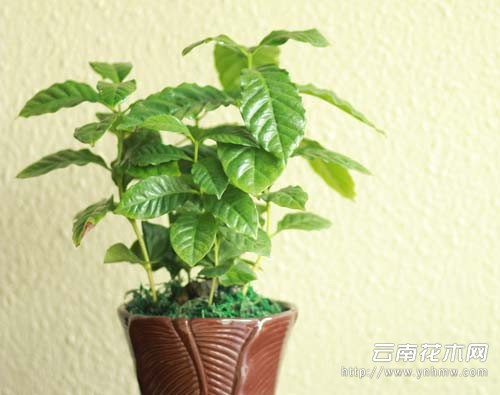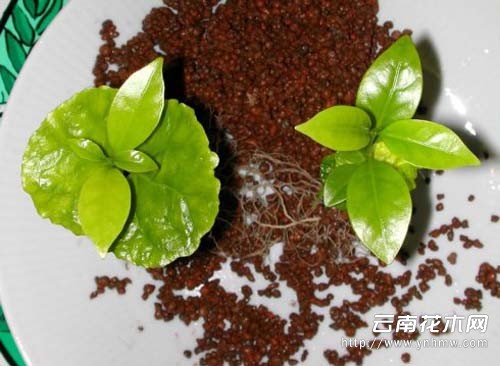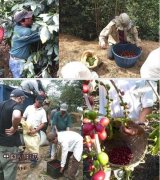Culture methods of potted Coffee trees the growth process of coffee trees
There are many coffee plants in Yunnan, and they are of good quality. This is the help given by the unique climate. The purpose of planting coffee trees is to harvest high-quality coffee beans, but the cultivation process is very strict, and it can be said that appropriate climatic conditions are needed: sunshine, rainfall, soil, temperature, as well as the way coffee beans are harvested and the process of production. will affect the quality of the coffee itself. The following Ziyun will explain the planting techniques and matters needing attention of potted coffee trees.

First, seeds: they can be picked by themselves or purchased online.
Second, seed treatment: carefully cut a small opening in the epidermis with a knife or scissors, and then peel off the skin. Be careful not to hurt the nuts inside.
Third, planting: the treated seeds can be planted directly or soaked in water before planting. Direct planting is very simple, put the seeds directly into vermiculite, the thickness of the surface soil and the thickness of the seeds can be the same; soaking varies according to different seasons. If it is spring and autumn, the time can be longer and summer shorter. It is best to use cold water to reduce the loss of seed nutrition. After soaking in water, as before, it is also put into vermiculite and the surface is covered with soil.
Fourth, seedling emergence: planting in spring and autumn, emergence in about 30 days; planting in summer, 7-10 emergence. Although there is heating in winter, there are still seasonal differences between winter and summer, so the emergence time is also very long.
Transplanting: when the true leaves of the seedlings grow, they can be transplanted. When selecting a flowerpot, the diameter of the pot mouth is roughly the same as that of the plant crown, and the root system can be extended.
Sixth, the choice of basin soil: the basin soil I choose is very simple, generally there are two kinds: one is garden soil. Garden soil alone can be maintained well; second, three-in-one: peat, vermiculite, perlite = 3:2:2.
7. Key points for maintenance:
(1) soil requirements: strictly speaking, coffee also likes weakly acidic soil, but the requirements are not very strict. So both the garden soil and the three-in-one soil can ensure its normal growth. If some fermented rice washing water is properly watered during the growth period, it will be helpful to maintain the acidity of the soil. Do not need to wash rice water, use ordinary dried tap water, also grow well.
(2) watering can be seen as dry and wet, and a large amount of water is needed in the seedling stage, which will cause the seedlings to dry a little bit carelessly, so be very careful and the basin soil should not be too dry. A year later, the seedlings will be more drought-tolerant, even if there is not enough water, it will not affect its growth.
(3) Illumination: coffee likes light, without sunlight, it will grow poorly. But summer also avoid exposure, exposure will lead to leaf damage, it is best to put in a place with scattered light to spend the summer.
(4) fertilization: the requirement of fertilizer for coffee is not high. I usually insert horseshoe directly into the basin and slowly dissolve and release fertilizer by watering.
(5) change the basin. Once a year. Remove the old roots and plant some of the original soil into the new pot.

Matters needing attention:
(1) Coffee is a tree, so during the growing period, the following leaves will gradually become old and yellowed, which is a normal phenomenon of plant growth, do not panic, pay attention to timely cleaning of old leaves and yellow leaves
(2) it takes three years for coffee to bloom. The flower has a jasmine-like aroma, which is lighter than jasmine, and has the bitter taste of coffee after taste. The flowering period is from February to May and blossoms continuously. Bear fruit after anthesis. The fruit is green. No artificial pollination is needed.
(3) if the coffee tree is to have luxuriant leaves and flowers, it needs to be properly pointed to promote its side branches to germinate and have a good-looking crown.
(4) with the increase of age, the trunk of the coffee tree becomes woody, the color of the stem changes from green to yellowish brown, and the epidermis is chapped. It's a normal phenomenon, never mind.
Important Notice :
前街咖啡 FrontStreet Coffee has moved to new addredd:
FrontStreet Coffee Address: 315,Donghua East Road,GuangZhou
Tel:020 38364473
- Prev

Explain the knowledge of coffee trees, picking and roasting of coffee beans
Coffee Tree Coffee Tree is an evergreen tree that can grow as high as a three-story building. However, generally planted coffee trees are trimmed to a height of less than two meters in order to facilitate harvesting. Coffee trees have white flowers, and the orchard has a faint jasmine fragrance when it blossoms. Like other fruit trees, coffee flowers turn dark green when they wither.
- Next

From the planting of coffee trees to the harvest of coffee beans, how to raise coffee trees
Coffee trees take 3-5 years from planting to fruiting. 6-10 years of coffee trees are the most likely to bear fruit, about 15-20 years, is the harvest period. Coffee trees are usually bred in nurseries and grow into saplings, and then moved to coffee farms a year later, in full compliance with the way the Arabs planted and cultivated coffee trees. Coffee trees will continue to take root downward and upward in the first four or five years of their growth.
Related
- Beginners will see the "Coffee pull flower" guide!
- What is the difference between ice blog purified milk and ordinary milk coffee?
- Why is the Philippines the largest producer of crops in Liberia?
- For coffee extraction, should the fine powder be retained?
- How does extracted espresso fill pressed powder? How much strength does it take to press the powder?
- How to make jasmine cold extract coffee? Is the jasmine + latte good?
- Will this little toy really make the coffee taste better? How does Lily Drip affect coffee extraction?
- Will the action of slapping the filter cup also affect coffee extraction?
- What's the difference between powder-to-water ratio and powder-to-liquid ratio?
- What is the Ethiopian local species? What does it have to do with Heirloom native species?

